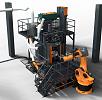General Manager
- FMA
- The Fabricator
- FABTECH
- Canadian Metalworking
Finishing Strong
- By Rob Henderson
- May 19, 2017
- Article
- Metal Finishing
When it comes to restoring the corrosion resistance of stainless steels, many methods are available, from pickling and passivation to mechanical abrasion. However, developments in electropolishing have led to a safe and efficient alternative for cleaning and matching stainless steel finishes.
The excellent corrosion resistance of stainless steel can be achieved only if proper cleaning and finishing operations are carried out after any fabrication process, as some damage to the surface during these processes is inevitable.
The corrosion resistance of stainless steel arises from a chromium oxide film that forms a protective layer naturally on the surface of the steel.
High welding temperatures result in severe chromium depletion not only at the weld surface but throughout the heat-affected area. Removing surface material such as oxide film is therefore only half the job as the weld area is still chromium depleted relative to the parent stainless steel. Critically, when the weld is depleted of chromium its corrosion resistance is severely reduced and the weld may also lose its reflectivity and cosmetic appeal.
Pickling
Pickling is the process of removing weld scale from the surface of a finished weld by cutting away some of the layers that have been affected by the weld through the use of acid concentrations.
Acid pickling is a hazardous procedure with both human health and environmental issues to be considered because of the toxic acids used in the various processes. If not carefully controlled, acid cleaning can also damage the surface of the welded object and may result in further contamination on the treated areas. Acid concentrations, temperatures, and contact times must therefore be closely monitored and controlled in relation to the treated alloy.
If health and safety regulations are followed, the setup, use, and disposal of pickling pastes becomes a costly exercise, both in terms of time and money. And although pickling removes the oxide scale, the weld area is still chromium depleted when compared to that of the parent metal.
The Electropolishing Alternative
Electropolishing is an electrochemical process used for finishing stainless steel that increases the density of the chromium throughout the treated area and therefore the ability to create this oxide film.
Electropolishing selectively dissolves the microscopic high points of the stainless steel and selectively removes iron, thereby increasing the chromium density and creating a microscopically smoother surface on which bacteria contaminants cannot bind or hide.
Research completed by the Intelligent Polymer Research Institute at the University of Wollongong in Australia shows that welds cleaned with direct current electrochemical brushes have significantly better corrosion resistance than pickling paste or an electrochemical cleaning brush using alternating current.
According to the research at the institute, “Welds cleaned … using DC have significantly better corrosion resistance due to reduced microscale and removal of large grain boundaries which lead to pitting (corrosion) than pickling paste and an electrochemical cleaning brush using alternating current. AC also show signs of contamination.”
Electropolishing machines have been designed in response to these studies, and when they are used correctly, they result in a cleaner weld finish. By using DC, the machines selectively dissolve the microscopic high points of the stainless and selectively remove iron.
Studies have also found that DC electropolishing improves the chromium density at the welded area beyond that of the parent metal. This means that the days of the “tea stain” weld zone are over.
According to Dr. Ian Ward, technical manager at Sandvik Materials Technology, the largest improvement in corrosion resistance was demonstrated by a mobile electropolishing unit with a carbon fibre brush. The unit exceeded the performance of the pickling paste and returned the overall corrosion resistance of the entire weldment “close to, and in some areas exceeding that of the parent metal.”
The DC process uses a food-grade acid that combines a citric and phosphoric acid with several sequestering agents to deliver improvements in operator safety.
In the past electropolishing could be performed only by the immersion of the work piece in an electrolyte solution, which wasn’t always possible, practical, or cost-effective. Now it is possible to weld on-site or in the workshop and only seconds later finish the weld with a chromium-dense, mirror-like sheen. The machines require minimal labour and thus yield faster production than other cleaning processes.
The machines return the characteristic properties of stainless steel to maximum effect, leaving it chromium-rich, metallically clean and free from stress, smoother with reduced microscopic cracks, with minimum absolute surface area, and chemically passive.
Rob Henderson is general manager, Metal Science Technologies, 02 4474 3394, www.metalscience.com.au.
About the Author
subscribe now


Keep up to date with the latest news, events, and technology for all things metal from our pair of monthly magazines written specifically for Canadian manufacturers!
Start Your Free Subscription- Trending Articles
FMA Annual Meeting: Ingenuity still key with tech innovations

Messer Canada hosts anniversary event

Welding jacket designed for protection, comfort

Gang punching press system accommodates different parts quickly

Compact swing chamber shot blast machine features robotic workpiece handling

- Industry Events
MME Saskatoon
- May 28, 2024
- Saskatoon, SK Canada
CME's Health & Safety Symposium for Manufacturers
- May 29, 2024
- Mississauga, ON Canada
DiPaolo Machine Tools Open House 2024
- June 4 - 5, 2024
- Mississauga, ON Canada
FABTECH Canada
- June 11 - 13, 2024
- Toronto, ON Canada
Zoller Open House & Technology Days 2024
- June 12 - 13, 2024
- Ann Arbor, MI


















